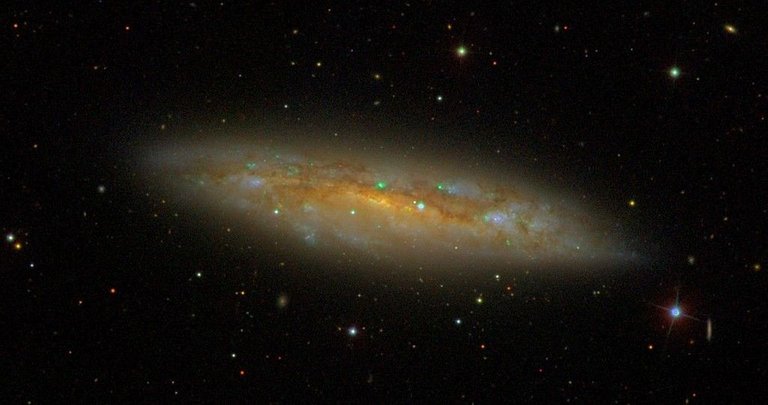Welcome to the next episode of my series about amateur observations of celestial bodies. Continuing the journey through the brighter galaxies of our sky, I would like to show you an interesting spiral galaxy, which we are able to see from the countryside with a telescope for around $300. Let's look at the galaxy marked in the Messier's catalog number 108.

By Sloan Digital Sky Survey link [CC BY 4.0 license]
In the constellation of Ursa Major there is at least some interesting objects. Some time ago I was describing to you the Owl nebula (M97), it is in its vicinity is the galaxy M108. We'll find her near the bottom of the Big Dipper. More precisely about 1 degree from the Merek star, visible on the map below. Both M108 and M97 have a similar brightness of around +10 magnitude, so they remain invisible to the unaided eye. In order to be able to see that these objects, we need a dark, rural sky during the new moon and 10 X 50 binoculars. Meeting these conditions will allow us to see both objects simultaneously in view. M97 will not be sharp, like a fuzzy star, and M108 will appear as a poorly visible. For the thirsty for real sensations, however, you need a stronger instrument, a telescope with a lens diameter of at least 8 inches (200 mm).

By IAU and Sky & Telescope magazine (Roger Sinnott & Rick Fienberg) link [CC BY 3.0 license]
For telescope owners, the size of the galaxy will be quite large, because it occupies an area of 9 X 2 arc minutes in the sky, for comparison the full Moon has a 30 arc minutes in the Earth sky. Using the smallest magnification with a wide-field eyepiece will allow you to see M97 and M108 together. This duet of nebula and galaxy is one of the coolest pairs of objects in the sky. In such a small magnification, the view resembles the one known from binoculars, but in the telescope we are sure of what we see: a fuzzy sphere and a fuzzy line. When we can get away from large cities and have a large 12-inch (300 mm) telescope or larger, a real feast awaits us. I saw a similar view to the simulation below in 2013 with my GSO 12-inch telescope during the astronomical rally in Roztoki Górne in the Polish Bieszczady mountains. The galaxy, at high magnification, showed its structure, dark matter bands and a few brighter stars visible in its background. To this day I remember this view, a distant object in such a quality, we see it as it was many millions of years ago.

(My modification) Original by Hewholooks link [CC BY-SA 3.0 license]
It is estimated that the M108 galaxy is located about 45 million light-years away from Earth, which is why we see it as it was 45 million years ago. M108 is moving away from us at a speed of 772 km / s. As you can see, galaxies are constantly changing their location. In galaxy M108 a supernova was observed. SN 1969B was observed in M108. On January 23, 1969, she reached the brightness of +13,9 magnitude (it was a very weak star, visible in the background of this galaxy only in large instruments). I hope that I have inspired some of you to be interested in the cosmos that opens over our heads every cloudless night.


This post has been voted on by the SteemSTEM curation team and voting trail in collaboration with @curie.
If you appreciate the work we are doing then consider voting both projects for witness by selecting stem.witness and curie!
For additional information please join us on the SteemSTEM discord and to get to know the rest of the community!